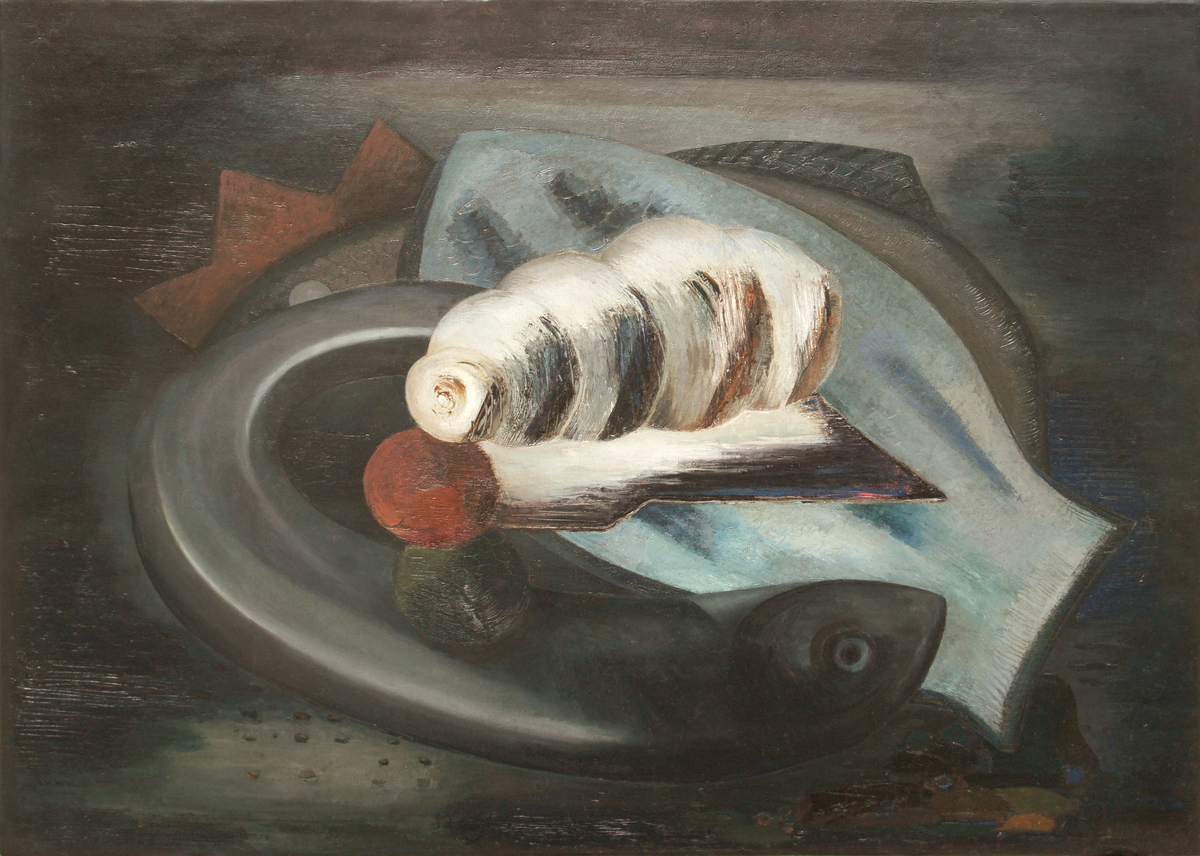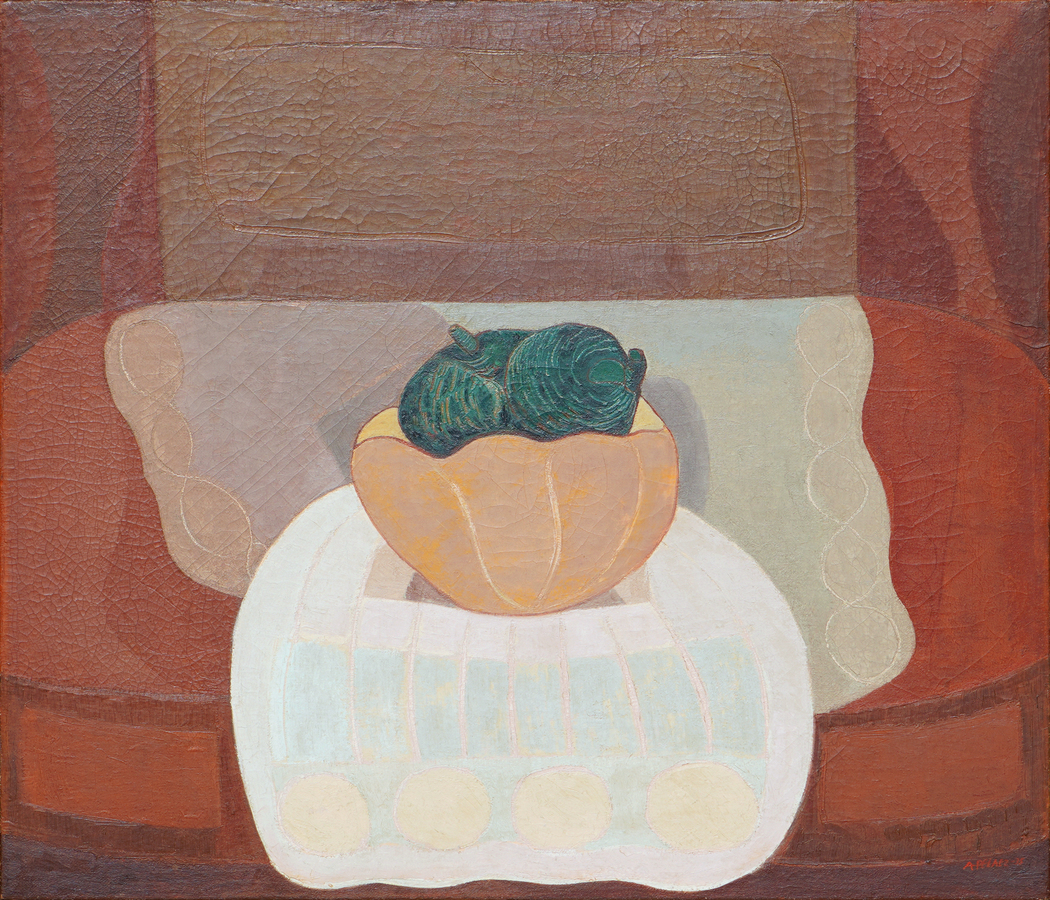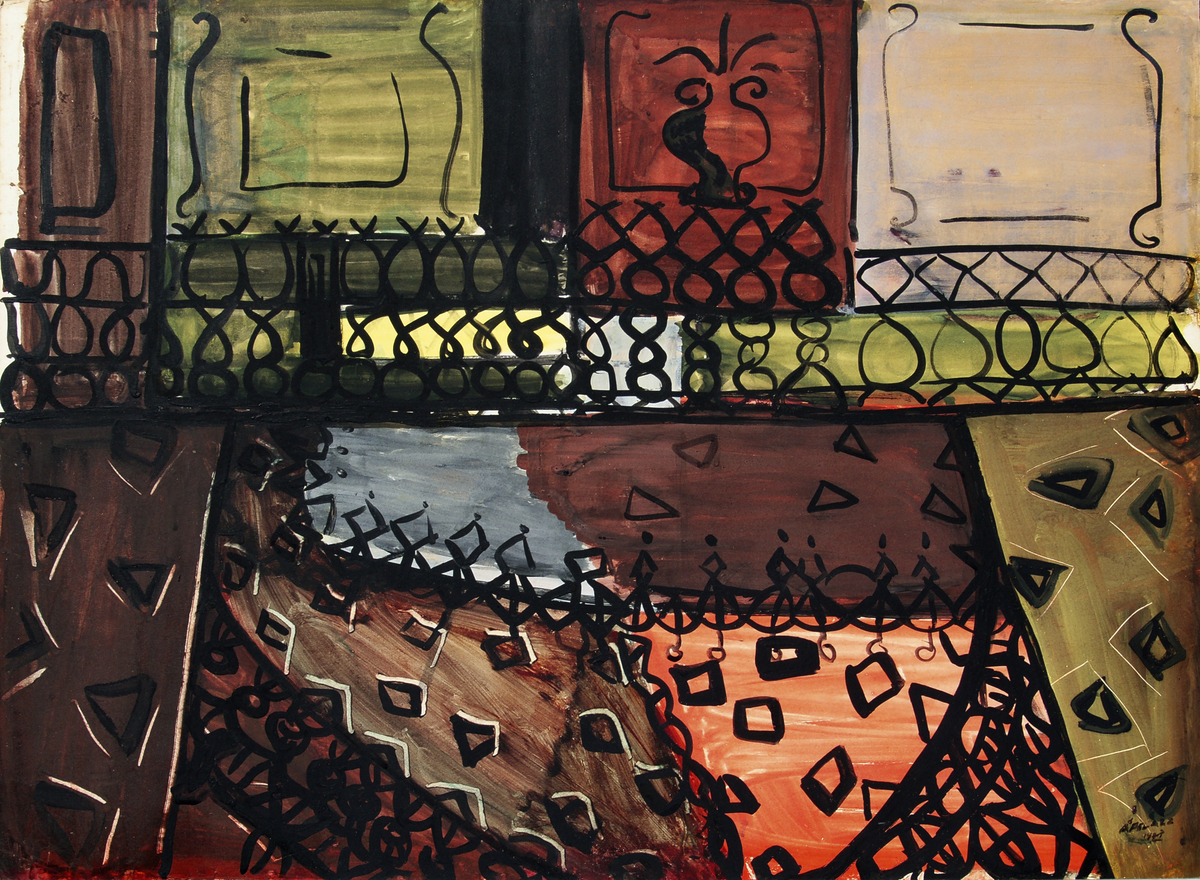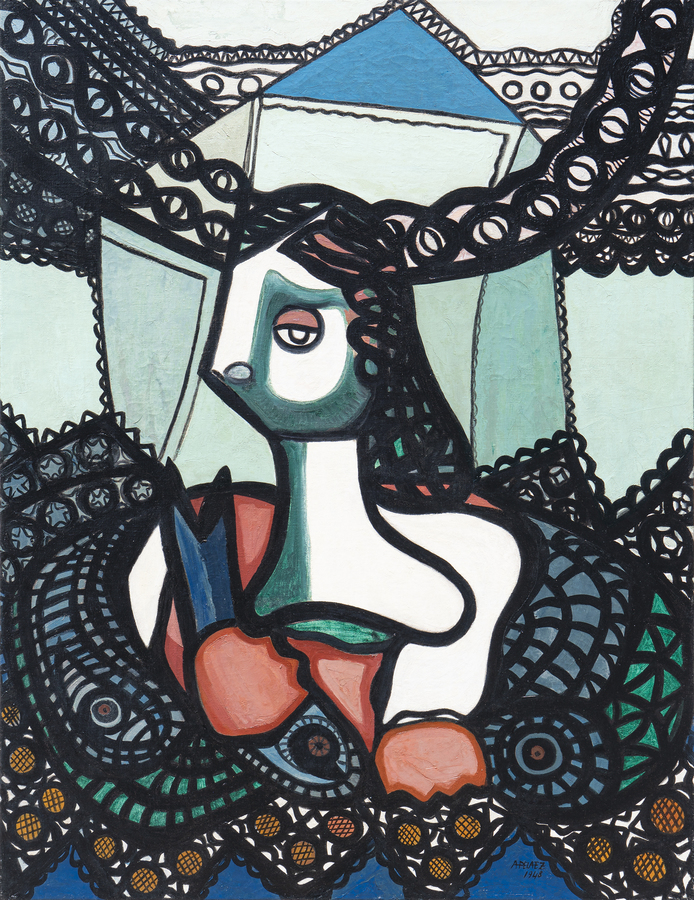| |
| Museum Quality Artworks In Exhibition at Cernuda Arte: Amelia Peláez |
| AMELIA PELÁEZ (1896-1968)
|
|
|
Considered a grand master of modern
Cuban art, and a seminal figure in 20th
century Latin American painting, Amelia
Peláez is one of the most acclaimed artists
of her times. Her contribution to the avant-
garde women’s movement in the arts-
internationally speaking- was a palmary
achievement.
Just like Frida Kahlo in Mexico and Tarsila
do Amaral in Brazil, Amelia -with her strong
artistic voice- was able to break through
the male dominant avant-garde movement
of the era, eventually becoming a pioneer
of Modernism in Cuba. The artist was first
trained in and graduated from San
Alejandro Academy in Havana under the
academic mindset that prevailed in this art
school. There, she excelled in painting,
drawing, ceramics and muralism.
|
|
|
|
 |
Amelia Peláez
Grey Fish
(Peces Grises), 1931
oil on canvas
38 x 51 inches
Provenance:
Luis Amado Blanco Collection, Havana, Cuba; Private Collection,
Los Angeles, California.
Exhibited in Amelia Peláez del Casal, January-February 1935,
Lyceum, Vedado, Havana, Cuba, and listed no. 19 (Pescado Gris)
in the exhibition brochure.
Exhibited in Exposición de Pintura, Víctor M. García, Amelia Peláez,
Domingo Ravenet and Carlos Enríquez, August 8, 1936, Lyceum,
Vedado, Havana, Cuba, and listed no. XII (Pescados Grises)
in the exhibition brochure.
Exhibited in Amelia Peláez, Exposición Retrospectiva, November 14,
1968, Museo Nacional de Bellas Artes, Havana, Cuba, and listed
in the corresponding exhibition catalog, no. 58.
Illustrated in Pintores Cubanos – Amelia Peláez, Alejandro G. Alonso,
Havana, Cuba, 1988, page 5.
Illustrated in Diálogos Constructivistas en la Vanguardia Cubana:
Amelia Peláez, Loló Soldevilla and Zilia Sánchez, Galerie Lelong,
New York, April-June 2016, page 6.
Illustrated in IMPORTANT CUBAN ARTWORKS, Volume Fourteen,
Cernuda Arte, Coral Gables, FL, 2016, page 22.
|
|
|
|
“[Amelia] Peláez studied with [Alexandra]
Exter in Paris from May 1931 to January
1934, shortly before her return to
Havana. During this time they worked in
collage, studied book illustration, created
set designs, and explored still life. Peláez
reported that she owed Exter ‘her
greatest advancement and technical
understanding'. Indeed Exter’s
experimental interpretation of Cubism
and Futurism, animated by the dynamic
potential of color, appears to have
inspired Peláez’s approach to a lifetime of
painting, even after her return to
Cuba [1934]…
Exter’s strategy of centering the
composition on a weighty object around
which swirled ‘whirlwinds of geometric
forms,’ often spinning off planes,
influenced Tatlin’s Monument to the Third
International (1919-1920), a work
foundational to Russian Constructivism.
Peláez also adopts Exter’s interest in
movement around a central pivot point in
her circa 1931-35 Pescados Grises (Grey
Fish). In their case a stylized, flattened
fish and still life object become the focal
point for the curved body of another,
nearly-living black fish that wraps around
them. This subtle movement may be the
beginning of the black arabesque that
would become the hallmark of Peláez’s
mature style…”
-Ingrid W. Elliot, Ph.D., excerpt from the
catalog essay Between the Real and the
Invisible, Diálogos Constructivistas en la
Vanguardia Cubana: Amelia Peláez, Loló
Soldevilla and Zilia Sánchez, Galerie
Lelong, New York, April-June 2016,
pages 5 and 6.
|
|
|
|
|
In 1924, the artist went on to travel to
New York where she studied at The Arts
Student League. Later on, in 1927, she
traveled to Europe, visited Spain, Italy,
and lived in Paris until 1934. It was in the
City of Light where Amelia absorbed the
European avant-garde movements.
Matisse, Leger, Picasso, Braque and Gris,
among others, shaped her imagery.
European trends as Cubism, Fauvism and
the Russian Avant Garde aided in
enriching the traditional instruction she
had received in San Alejandro. It was
then that Amelia began to forge her own
artistic vocabulary, marked with her
superb force and sensibility.
While in Paris, she studied at the Academié de
la Grande Chaumière, and later entered the
École Supérieure des Beaux-Arts, and the
École du Louvre. To broaden her knowledge,
she visited an array of museums, mingled with
the social artistic circles of the city, and
became a close friend of the Cuban writer and
intellectual, Lydia Cabrera who at that time
was also living in Paris. Her studies in design
and color theory with Russian avant-garde
artist, Alexandra Exter (from 1931 to 1934)
expanded the development of her formal
training and awakened her interest in Cubism.
|
|
|
|
|
|
Peláez earned her peers’ admiration in
Europe with her first Parisian solo show
in 1933 at the prestigious Galerie Zak,
which at the time was a most important
venue for contemporary art exhibitions -
staging works by Chagall, Picasso,
Modigliani and Gris, among others. To
exhibit at Galerie Zak implied a level of
recognition that elevated Amelia in the
eyes of the arts community.
In 1934, Amelia returned to Cuba at the
age of 37. She then joined the active
cultural circles in the island. A year later,
the artist showcased her European works
at the Lyceum, an important forum for
female painters. In 1939, Amelia’s works
were presented in New York for the first
time, as part of the group show Latin
American Exhibition of Fine and Applied
Art at the Riverside Museum.
|
|
|
 |
Amelia Peláez
Still Life with Fruits
(Naturaleza Muerta con Frutas), 1935
oil on canvas
27 3/4 x 32 inches
Exhibited in Amelia Peláez, A Retrospective, National Museum
of Fine Arts, Havana, Cuba, November 1968, and listed number
60 in the exhibition catalog.
Exhibited in Amelia Peláez, The Craft of Modernity, Perez Art
Museum, Miami, December 2013 and illustrated in the
accompanying exhibition book, pages 44 & 45.
Illustrated in the book Amelia Peláez, Alejandro Alonso,
Editorial Letras Cubanas, Havana, Cuba, 1988,
pages 20 & 21.
Illustrated in the book Amelia Peláez, Ceramica, María Elena
Jubrías, Ediciones Vanguardía Cubana, Fundación Arte Cubano,
Escandón Editores, 2008, Sevilla, Spain, page 18.
Illustrated in IMPORTANT CUBAN ARTWORKS, Volume Five,
Cernuda Arte, Coral Gables, FL, 2006, back cover of catalog.
To be illustrated in the upcoming catalog, IMPORTANT CUBAN
ARTWORKS, Volume Nineteen, Cernuda Arte, Coral Gables,
Florida, available December of 2022.
|
|
|
|
In Havana, the artist established her
studio in her beloved home in La
Víbora district and worked with quiet
determination. During the 1940s,
Amelia perfected her craft and
grounded her signature cubist style.
The artistic circles in Cuba were much
captivated by her work, which was
featured and lauded in various solo
and group exhibitions where she
garnered several salon prizes. She
was one of the few women who were
selected to participate in the
important Art in Cuba show at the
University of Havana in 1940. Her first
retrospective took place at the
Institución Hispano-Cubana de
Cultura in 1943.
Internationally, the artist was also
garnering attention throughout the
1940’s. In 1941, Peláez had her first
one-person exhibition in New York
City, Amelia Peláez at the gallery
Norte. Her presence in this show, as
well as in the corresponding
publication of the same name, piqued
the interest of the Museum of Modern
Art (MoMA) in New York, and led to
them purchasing several of her works
in years that followed. 1943 marked
her first showing at the prestigious
MoMA, as part of the group exhibition
The Latin American Collection of The
Museum of Modern Art. This would be
the first of 13 MoMA exhibitions which
included the artist’s work.
|
|
|
|
|
Moreover, in 1944, Amelia was one of
the 13 artists included in the ground
breaking exhibition, Modern Cuban
Painters at MoMA, curated by Alfred
Barr. The exhibition, which showcased
Cuban art as a highlight of the
contemporary art world for the first
time, presented 11 works of the artist.
The show then traveled to twelve
museums across the United States
including, the National Gallery in
Washington D.C. and the San
Francisco Museum of Modern Art. By
this time, Amelia played a vital role as
a key disseminator of a new national
culture that engaged not only with the
island’s emerging modern art scene,
but also, with the broader
international narratives of modernity. The
artist had generated considerable
momentum. Works from her 1940’s
period remain among the most
favored by collectors, critics, and
institutions.
|
|
|
|
 |
Amelia Peláez
Interior with Balcony
(Interior con Balcón), 1947
mixed media on heavy paper laid down on board
22 x 30 inches
Exhibited at the Pérez Art Museum in Amelia Peláez: The Craft of
Modernity, Miami, FL, Dec. 4, 2013 to Feb. 23, 2014, and illustrated
in the corresponding catalog, page 91.
Exhibited at the Florida State University Museum of Fine Arts in
Cuban Art in the 20th Century: Cultural Identity and the International
Avant Garde, Tallahassee, FL, Feb. 12 – Mar. 27, 2016, and illustrated
on the cover and on page 81 of the accompanying catalog.
Also exhibited in Cuban Art in the 20th Century: Cultural Identity and
the International Avant Garde at the Coral Gables Museum,
Coral Gables, FL, January 23 to April 23, 2017.
Illustrated in IMPORTANT CUBAN ARTWORKS, Volume Ten,
Cernuda Arte, Coral Gables, FL, 2011, page 22.
|
|
|
|
In the most insightful analysis of
[Amelia] Peláez’s stylistic sources in
Cuban architectural decoration,
artist Robert Altmann introduced the
issue: “The paintings of Amelia
Peláez are a conscious vision of the
dominant role of ornament in
relation to the theme of still life and
of the elements of Cuban
ornamental art of the last century.”
(1) “In her own studio,” he
observed, “Amelia Peláez
accumulates vestiges of the colonial
past: corinthian columns,
mamparas, sculpted chairs, and
other objects that remind her at
every glance of a precise stylistic
language [that of Cuban nineteenth-
century ornamental art].”(2) About
the specific connections between her
style and the precise visual language
of colonial architectural decoration,
Altmann was one of the first to point
out that her use of color and
chiaroscuro suggests the filtration of
light created by the medio punto,
and that her linear arabesques
construct a limited, static space
defined by perforated screens
parallel to the picture plane, not
unlike the space found in traditional
Cuban ornamental iron and wood
works. He concluded that Peláez’s
paintings were a carryover and a
rehabilitation of forgotten
ornamental tradition found in Cuban
nineteenth and early-twentieth-
century architecture and crafts.
(1)(2)Robert Altmann, “Ornamento y
Naturaleza Muerta en la Pintura de
Amelia Peláez”, Orígenes, La
Habana, No. 8, Invierno, 1945.
-Professor Juan A. Martínez, Cuban
Art and National Identity, The
Vanguardia Painters, University
Press of Florida, 1994, page 133.
|
|
|
|
|
Her paintings were featured in the
São Paulo Art Biennial in 1951 and
1957, and she also participated in
1952’s Venice Biennale. In 1958 she
was a guest of honor and integrated
the International Jury of the first
Inter-American Painting and Drawing
Biennale in Mexico. She has had
major retrospective exhibitions at
the Museo Nacional in Havana 1968,
the Cuban Museum of Art and
Culture in Miami 1988, and the
Fundación Museo de Bellas Artes in
Caracas 1991. In 1997, a major
exhibition in Spain featured her as
one of the three most influential
Latin American women master
artists in an exhibition entitled,
Tarsila, Frida, Amelia (Tarsila do
Amaral, Frida Khalo, Amelia Peláez).
More recently, Amelia Peláez’s work
has been celebrated in various
significant exhibitions including
Cuban Art and Identity, 1900-1950
at the Vero Beach Museum of Art in
October of 2013. In December of
2013, a major solo retrospective on
her work, Amelia Peláez: The Craft
of Modernity, inaugurated the Perez
Art Museum Miami. In 2016,
Amelia’s work was prominently
featured in the show Cuban Art in
the 20th Century: Cultural Identity
and the International Avant Garde,
which opened at the Museum of Fine
Arts in Tallahassee and later traveled
to the Coral Gables Museum in 2017.
In 2018, works by Amelia were
featured at the Americas Society in
New York City as part of the
exhibition Lydia Cabrera and
Édouard Glissant: Trembling
Thinking, and from 2019 to early
2020, she was featured in the show
Where the Oceans Meet at the
Museum of Art and Design at
Miami’s Freedom Tower.
Important examples of her paintings
are present in the permanent
collections of: Museum of Modern
Art in New York; Art Museum of the
Americas in Washington, D.C.;
Museum of Modern Art in San
Francisco; Museum of Arts and
Science in Daytona Beach, FL;
Bacardi Art Collection; Museum of
Modern Art in Mexico City; Museum
of Modern Art in Bogota, Colombia;
National Museum of Fine Arts in
Havana, Cuba; Museum of Latin
American Art in Buenos Aires,
Argentina; Museum of Fine Arts in
Caracas, Venezuela, among others.
|
|
|
|
 |
Amelia Peláez
Woman with Fish
(Mujer con Pez), 1948
oil on canvas
52 x 40 inches
Provenance:
Collection of Dulce María Loynaz del Castillo, poet;
Private Collection, Dominican Republic.
Exhibited in Miami Currents: Linking Collection and Community,
Miami Art Museum of Dade County (MAM), Miami, Florida,
October 30, 2002 – March 2, 2003.
Exhibited in Amelia Peláez: The Craft of Modernity, Pérez Art Museum
Miami, Miami, Florida, December 4, 2013 – February 23, 2014.
Exhibited in Lydia Cabrera and Édouard Glissant: Trembling Thinking,
Americas Society, New York, NY, October 9, 2018 - January 12, 2019.
Exhibited in Where the Oceans Meet, Museum of Art and Design,
Miami Dade College’s Freedom Tower, May 26, 2019–January 12, 2020.
Illustrated in Cuban Art & Identity: 1900-1950, Dr. Juan A. Martínez,
Vero Beach Museum of Art, Vero Beach, Florida, 2013, page 39.
Illustrated in the book Amelia Peláez: The Craft of Modernity,
René Morales and Ingrid S. Elliott, Pérez Art Museum Miami,
Miami, FL, 2013, pages 92 and 93.
Illustrated in the scholarly publication ARAS Connections, Amelia:
Images of Mystery, the Transformation of Shadow in Women, Joan
Golden-Alexis, Archive for Research in Archetypal Symbolism,
Issue 3, New York, NY, 2018, pages 18 and 24, with critical text
on page 24 and 25.
Illustrated in “Lydia Cabrera and Édouard Glissant: Trembling
Thinking,” Elvis Fuentes, ArtNexus Magazine, no. 111, Bogota,
Colombia, Dec. – Feb. 2019.
|
|
|
|
|
| |
| |
| |
| Copyright 2002-2025, Cernuda Arte. All Rights Reserved |
| |
|
| |
